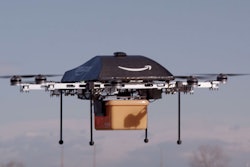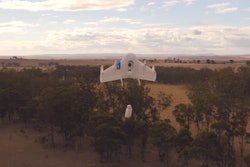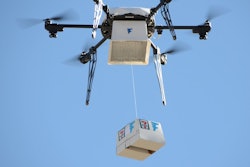
In an exclusive interview with Yahoo! Tech, Paul Misener, the vice president for global public policy at Amazon, discussed Amazon Prime Air, the online retailer’s drone delivery program, including details that weren’t previously made public. Among the information that Misener shared:
- Each drone will weigh about 55 pounds, and be capable of delivering packages of up to 5 pounds to customers within 10 miles or more of a fulfillment center. (The 5-pound payload capacity would fulfill the vast majority of Amazon orders.)
- The goal is for customers to receive items within 30 minutes of placing orders. (If no one is home, the package will be dropped off on the doorstep or some other customer-designated spot, just as it would be in the case of a truck delivery.)
- Amazon is designing models for specific types of weather and for different terrains, from rural farms and dusty deserts to mountainous regions, urban skyscrapers and elsewhere.
- The drones will be able to identify and avoid obstacles—to act “more like horses than cars,” as Misener put it.
- Suppressing drone noises to avoid irritating, alarming or disturbing people remains a challenge.
- Amazon is hoping to convince the Federal Aviation Administration (FAA) to create a window from 200 to 400 feet above the ground for commercial drones to occupy, with a safety buffer from 400 to 500 feet. (They’d be allowed to drop to ground level for takeoffs and landings.)
This is just the latest in an ever-growing series of reports about commercial uses for unarmed aircraft systems (UAS). Google is testing them, in collaboration with NASA, for undetermined purposes. Walmart is testing them for inventory, distribution and delivery purposes. Over 500 companies already received Section 333 exemptions to use drones for aerial photography, golf course designing, crop monitoring and numerous other functions. (Exempted firms can’t fly within 5 miles of an airport or wander into other FAA-prohibited airspace, and they currently have to stay within 200 feet of the ground.)
While the U.S. military saw a record number of major drone accidents in 2015, the technology for domestic UAS is far ahead of the regulations needed to ensure safety in our skies. Perhaps the biggest threat right now—both to and from drones—is the increasing number of amateur pilots. An estimated 1 million drones were sold during the 2015 holiday season, yet brand-new flyers face fewer restrictions than commercial users do.
Amateurs are required to register their UAS with the government and fly them within sightlines at all times, but they don’t even have to read a user manual before lifting off, while commercial pilots can’t fly without a pilot’s license. This disparity is due to congressional legislation that removed model aviation hobbyists from FAA oversight in 2012. Since then, state and local governments tried to impose some sort of order on their own airspaces. This resulted in a patchwork quilt of laws, statutes and ordinances across the country, some of which clashed with and were overturned by the FAA.
The FAA is expected to issue new commercial drone regulations some time this spring. Until then, the drone plans for Amazon and other retailers will remain in a bit of a holding pattern. Even after the rules of the air are established, though, drone usage will still face challenges. The primary obstacle, in more ways than one, is likely to be consumer acceptance.
A major difference between road and air deliveries is that truck and van drivers are required to stay on public property until they reach their destinations. The obvious advantage of drones is that they can travel literally as the crow flies, i.e., in a fairly direct line from the warehouse to the customer’s address, unimpeded by stop lights, speed limits or concerns about trespassing over private property. Shorter routes significantly reduce a drone’s drop-off times compared to ground transportation options.
Unfortunately, those routes can also raise concerns about property and privacy rights. Last summer, a Kentucky man shot down a privately owned UAS that was flying over his yard, referring to a “full protect my home … and my American rights mode” as his defense against two felony counts. However, the drone owner recently sued him in federal court. In addition to restitution for lost property, the owner is seeking a ruling to “resolve the boundaries of the airspace surrounding property, and the right to damage or destroy an aircraft in flight.”
Until a federal judge (and/or the FAA) weighs in, the FAA said that, as long as they don’t endanger anyone, UAS can legally hover inches above someone else’s property—but operators can also be prosecuted according to state or local noise and nuisance laws. Retailers, of course, will have every reason to keep their drones’ behavior above reproach. When asked about thieves shooting them down to steal cargo, though, Misener, the Amazon vice president, suggested that truck deliverers face similar risks and predicted that drone drop-offs will become commonplace once the novelty wears off.
Naturally, it’s the deep-pocketed retailers that are trying to make UAS deliveries routine. Amazon and Walmart can afford to fund research and development, build viable fleets, and handle the other factors needed to bring their plans to fruition. Specialty stores, regional chains and local merchants may occasionally be able to, say, piggyback on Prime Air as third-party retailers, but they’re unlikely to have the revenue needed to finance such ventures.
Fortunately for them, other alternatives will continue to emerge. Starship Technologies, for example, is working on self-driving earthbound robots that use pedestrian walking routes to deliver up to two grocery bags’ worth of products to customers within 30 minutes. They have limited ranges and they’ll have to address many of the same obstacles that UAS face: consumer awareness and acceptance; weather and traffic conditions; unruly pets; and a host of liability and feasibility issues. If they work, though, the robots will provide quick, convenient deliveries at a fraction of the cost of current last-mile options, all of which appeals to retailers and customers alike.
On the other hand, the R&D and ongoing maintenance costs of drones seem to necessitate higher delivery charges. In his Yahoo! Tech interview, Misener said Amazon didn’t make any Prime Air pricing decisions yet. While he gave no indication of how the costs might be split between Amazon and its customers, one thing is certain: Whatever the price may be, Prime members will receive a better offer than non-members will.
Despite the various regulatory, consumer and pricing concerns, retail drone deliveries draw closer each day and it’s easy to understand why. As e-commerce continues to grow, the battle for online consumers’ hearts and wallets is intensifying, too. Providing near-instant gratification for online purchases will attract and please customers, which will build or reinforce their loyalty to stores. This, in turn, will create a strong competitive edge for stores that offer the service. Amazon already enjoys a number of advantages over its rivals on land; the arrival of the drones will likely turn the online retail giant into a dominant air force as well.



















